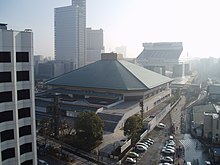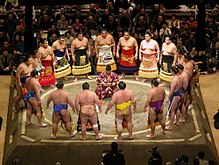Hon-basho

Hon-Basho ( Japanese本 場所), often short Basho , are the tournaments in Japanese sumo , in which the promotion and relegation of the wrestlers in the various leagues ("divisions") is decided. The name means mutatis mutandis "real competition" to the honbasho of the intervening held tours ( jungyo in Japan or Kōen to distinguish abroad). These smaller "tournaments" are also called Taikai (大会) or Tōnamento (ト ー ナ メ ン ト, from English tournament ); they have no meaning for the ranking of the wrestlers.
Because sumo, or more precisely: the (professional) Ōzumō , is still a popular public sport in Japan despite the overall decline in interest, the tournaments are well-attended major events.
Up until 1926 there were only two tournaments a year. That changed after the establishment of the Dai-Nihon Sumō Kyōkai ; from 1927 the number of tournaments was doubled to four, three of which were held in Tokyo and one in Osaka . Only two or three tournaments were held between 1933 and 1952 (only one in 1946). The November tournament in Fukuoka was introduced in 1957 , and the summer tournament in Nagoya followed the next year , so that from 1958 the number of six tournaments per year, which has been maintained to this day, was reached.
The order of the tournaments is as follows:
| designation | Japanese font | German | Date (first day of the tournament) * | city | venue |
|---|---|---|---|---|---|
| Hatsu basho | 初 場所 | First tournament | Second Sunday in January | Tokyo | Ryogoku Kokugikan |
| Haru basho | 春 場所 | Spring tournament | Second Sunday in March | Osaka | Osaka Prefectural Sports Hall |
| Natsu basho | 夏 場所 | Summer tournament | Second Sunday in May | Tokyo | Ryogoku Kokugikan |
| Nagoya Basho | 名古屋 場所 | Nagoya tournament | Second Sunday in July | Nagoya | Aichi Prefectural Sports Hall |
| Aki basho | 秋 場所 | Autumn tournament | Second Sunday in September | Tokyo | Ryogoku Kokugikan |
| Kyushu basho | 九州 場所 | Kyushu tournament | Second Sunday in November | Fukuoka | Fukuoka International Conference Center |
* this deadline is not always strictly adhered to, deviations occur.
Until 1949 the tournaments lasted ten days, since then there has been fought for 15 days, so that each tournament ends on a Sunday. The rikishi in the classes under the juryo division only wrestle for seven days.
Mostly 13 days before the start of the tournament, the official ranking list, the so-called banzuke (番 付), appears. B. due to public holidays deviations from the date.
daily routine
The order of the fights is based on the hierarchy of the wrestlers. The rikishi (sumo wrestlers) of the lowest class, the Jonokuchi division, start in the morning. Between the third and the eighth day, the so-called Mae Sumo or Sumo beginners take place, who are competing for the first time and have not yet been accepted into the lowest division. It is followed by the Jonidan Division and so on. The ring staff also changes between the individual divisions. H. the Gyōji , Shimpan and Yobidashi , who are also being replaced by higher-ranking colleagues. The Makuuchi Division also changes between the individual fights in order to adjust the rank of the ring personnel to that of the fighters. The last fights of the day are ultimately fought by the highest-ranking sumo wrestlers, the sanyaku and finally the yokozuna . They represent the highlight of the tournament day.
Most of the spectators do not appear until the fighting in the upper divisions, which begins in the afternoon. The meetings between the juryo and makuuchi are also broadcast by Japanese state television via satellite, the latter even with bilingual commentary ( Japanese , English ).
The fights of the top division are preceded by the ceremonial entry ( Dohyō-iri ) of the wrestlers dressed in splendid aprons ( Kesho-mawashi ). Only holders of the yokozuna rank do not take part, but have their own ceremony (see article Yokozuna ).
The day ends with the " archery dance " or yumitori-shiki , in which a single sumo wrestler performs with a bow . For this purpose, members of the Makushita division are usually determined who belong to the same wrestling stable ( heya ) as the dominant yokozuna.
The planning of the pairings takes place from day to day and is based on the previous performance of the participants, since the most balanced encounters are aimed for. If after 15 days no fighter has achieved the sole lead, there will be an elimination match ( Ketteni-sen ) between the tied competitors on the last day until a wrestler has achieved the tournament victory ( Yūshō ). The victory in a tournament with 15 wins and therefore without defeat is called Zensho-Yūshō .
Prices
The so-called Kaiser Cup is presented to the winner as a trophy, and there are three other awards that are awarded. These Sanshō are:
- Ginō-shō , the award for outstanding technology,
- Shukun-shō , the award for special achievement, and
- Kantō-shō , the award for exceptional fighting spirit.
These prizes are only given to rikishi who have achieved a kachi-koshi , i.e. H. when there are more victories than defeats. Ōzeki and yokozuna are excluded from the award.

